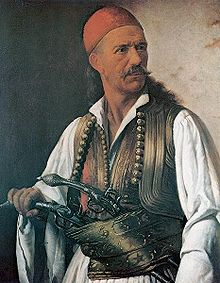
Klepht

Klephts (/klɛfts/; Greek κλέφτης, kléftis, pl. κλέφτες, kléftes, which means "thieves" and perhaps originally meant just "brigand"[2]) were highwaymen turned self-appointed armatoloi, anti-Ottoman insurgents, and warlike mountain-folk who lived in the countryside when Greece was a part of the Ottoman Empire.[2][3] They were the descendants of Greeks who retreated into the mountains during the 15th century in order to avoid Ottoman rule.[4] Klepht bands also included many ethnic Albanians.[5] They carried on a continuous war against Ottoman rule and remained active as brigands until the 19th century.[4][6]

The terms kleptomania and kleptocracy are derived from the same Greek root, κλέπτειν (kléptein), "to steal".[7]

Origins
After the Fall of Constantinople in 1453 and then the fall of Mistra in the Despotate of the Morea, most of the plains of present-day Greece fell entirely into the hands of the Ottoman Empire. The only territories that did not fall under Ottoman rule were the mountain ranges (populated by Greeks and inaccessible to the Ottoman Turks), as well as a handful of islands and coastal possessions under the control of Venice. This situation lasted until 1821. However, the newly acquired territories of Greece, such as Macedonia, Thrace and Epirus, were in Turkish hands until the 20th century. This period of time in Greece is known as the Turkocracy.

Ottoman lands were divided up into pashaliks, also called eyalets; in the case of the lands that form present-day Greece, these were Morea and Roumelia. Pashaliks were further sub-divided into sanjaks which were often divided into feudal chifliks (Turkish çiftlik (farm), Greek τσιφλίκι tsifliki). Any surviving Greek troops, whether regular Byzantine forces, local militia, or mercenaries had either to join the Ottoman army as janissaries, serve in the private army of a local Ottoman notable, or fend for themselves. Many Greeks wishing to preserve their Greek identity, Orthodox Christian religion, and independence chose the difficult but liberated life of a bandit. These bandit groups soon found their ranks swelled with impoverished and/or adventurous peasants, societal outcasts, and escaped criminals.

Klephts under Ottoman rule were generally men who were fleeing vendettas or taxes, debts and reprisals from Ottoman officials. They raided travelers and isolated settlements and lived in the rugged mountains and back country. Most klephtic bands participated in some form in the Greek War of Independence. During the Greek War of Independence, the klephts, along with the armatoloi, formed the nucleus of the Greek fighting forces, and played a prominent part throughout its duration. Despite being ineffective, they were the only viable military force for the provisional governments of the 1821–1827 period. During that time period, three attempts were made at creating a regular army, and one of the reasons for their failure was the resistance of the klepht and armatoles leaders.[8] Yannis Makriyannis referred to the "klephtes and armatoloi" as the "yeast of liberty".[9] John Koliopoulos studied the klephts in the 19th century, and stated that the principle of kinship and honour seen in Albanian besa could be seen among the klephts after centuries of contact with Albanian irregulars.[10]

Contrary to conventional Greek history, many of the klephts and armatoles participated at the Greek War of Independence according to their own militaristic patron-client terms. They saw the war as an economic and political opportunity to expand their areas of operation.[8][11] Balkan bandits such as the klephts and armatoles – glorified in nationalist historiography as national heroes – were actually driven by economic interests, were not aware of national projects, made alliances with the Ottomans and robbed Christians as much as Muslims.[12][13]

Songs

Klephtic songs (κλέφτικα τραγούδια), or ballads, were developed in mainland Greece.[14] They are part of the Greek folk music genre, which includes folk poetry, and are thematically oriented on either the achievements and death of a single klepht or the generic life of the klephts as a group.[14] Klephtic songs are especially popular in Epirus and the Peloponnese. The Czech composer Antonín Dvořák wrote a song-cycle named Three Modern Greek Poems: the first one is entitled "Koljas – Klepht Song" and tells the story of Koljas, the klepht who killed the famous Ali Pasha.

The most famous klephtic and modern Greek folk song is The Battle of Mount Olympus and Mount Kisavos, a ballad based on a musico-poetic motif dating back to classical Greece (specifically to the poetic song composed by Corinna pertaining to a contest between Mount Helicon and Mount Cithaeron).[14]

Cuisine
The famous Greek dish klephtiko (or kleftiko), a dish entailing slow-cooked lamb (or other meat), can be translated "in the style of the klephts". The klephts, not having flocks of their own, would steal lambs or goats and cook the meat in a sealed pit to avoid the smoke being seen.

Famous klephts
- Antonis Katsantonis
- Giorgakis Olympios
- Odysseas Androutsos
- Athanasios Diakos
- Geórgios Karaïskákis
- Theodoros Kolokotronis
- Dimitrios Makris
- Nikitas Stamatelopoulos
See also
References
Citations
- ^ Dontas 1966, p. 24: "Born in 1800, Demetrios Makris, a kleftis, had succeeded his father to the kapetaniliki in the district of Zyghos. A simple yet very stubborn man, like Dimo - Tselios he was a great patriot."
- ^ a b Encyclopædia Britannica, Inc 1995, p. 564: "Other Greeks, taking to the mountains, became unofficial, self-appointed armatoles and were known as klephts (from the Greek kleptes, "brigand")."
- ^ Sowards 1989, p. 75: "Greek irregulars had operated as bandit klephts and anti-Ottoman insurgents since before the Greek War of Independence in the 1820s."
- ^ a b Cavendish 2009, p. 1478: "The klephts were descendants of Greeks who fled into the mountains to avoid the Turks in the fifteenth century and who remained active as brigands into the nineteenth century."
- ^ Erdem 2007, pp. 224–225: "He commanded the loyalty of the klepht bands, which had life styles similar to those of the Albanians and in fact included many ethnic Albanians."
- ^ Encyclopedia Americana 1919, p. 472: "KLEPTHS, klēfts (Greek, "thieves"). Greek bandits who, after the conquest of Greece by the Turks in the 15th century, kept themselves free in the mountains of northern Greece and Macedonia, and carried on a perpetual war against Turkish rule, considering everything belonging to a Turk a lawful prize."
- ^ Encyclopedia Americana 1919, "KLEPTOMANIA", p. 472.
- ^ a b Davis, D. E. (2003). Irregular Armed Forces and their Role in Politics and State Formation. Cambridge University Press. p. 154.
- ^ Vacalopoulos 1961, p. 333: "Οί πυρήνες τών μαχητικών του δυνάμεων είναι οί άρματολοί καΐ οί κλέφτες ... ν'άποτελέσουν τήν «μαγιά της λευτεριάς», όπως παραστατικά λέγει ό άγωνιστής τοϋ 21 Γιάννης Μακρυγιάννης."
- ^ Reid, James J. (2000). Crisis of the Ottoman Empire: Prelude to Collapse 1839-1878. Franz Steiner Verlag. p. 114. ISBN 978-3-515-07687-6. Retrieved 10 April 2020.
- ^ Cronin, S. (2008). Subalterns and Social Protest: History from Below in the Middle East and North Africa. Routledge. p. 264.
- ^ Malesevic, S. (2013). Nation-States and Nationalisms: Organization, Ideology and Solidarity. Polity Press. p. 111.
- ^ Hall, J. A.; Malešević, S. (2013). Nationalism and War. Cambridge University Press. p. 258.
- ^ a b c Trypanis 1981, "The Klephtic ballads", pp. 592–594: "The Klephtic ballads developed in mainland Greece, and in the eighteenth century represented the final and supreme stage in the evolution of modern Greek folk poetry. They can be separated into two groups, one dealing with the achievements or the death of an individual Klepht and the second with the life of the Klephts in general...Among them is a notable series of songs that deal with battles between mountains, a motif that goes back to antiquity, as we know from a fragment of Corinna found on a second-century papyrus in which Mount Helicon and Mount Cithaeron are fighting. Such battles of mountains in Greek folk songs have survived in Crete and in Karpathos, but the most famous of all is the Pan-Hellenic ballad of The Battle between Mount Olympus and Mount Kisavos."
Sources
- Cavendish, Marshall (2009). World and Its Peoples. Marshall Cavendish. ISBN 978-0-7614-7902-4.
- Encyclopedia Americana (1919). The Encyclopedia Americana: A Library of Universal Knowledge, Volume 16. New York and Chicago: Encyclopedia Americana Corporation.
- Encyclopædia Britannica, Inc (1995). The New Encyclopædia Britannica, Volume 1. Encyclopædia Britannica. ISBN 0-85229-605-3.
- Dontas, Domna N. (1966). The Last Phase of the War of Independence in Western Greece (December 1827 to May 1829). Thessaloniki: Institute for Balkan Studies.
- Erdem, Hakan (2007). ""Perfidious Albanians" and "zealous governors": Ottomans, Albanians, and Turks in the Greek War of Independence". In Antonis Anastasopoulos, Elias Kolovos (ed.). Ottoman Rule and the Balkans, 1760-1850: Conflict, Transformation, Adaptation. Proceedings of an international conference held in Rethymno, Greece, 13-14 December 2003. University of Crete, Department of History and Archaeology. pp. 213–242. ISBN 978-960-88394-4-1.
- Sowards, Steven W. (1989). Austria's Policy of Macedonian Reform. East European Monographs. ISBN 0-88033-157-7.
- Trypanis, Constantine Athanasius (1981). Greek Poetry: From Homer to Seferis. Chicago: The University of Chicago Press. ISBN 0-226-81316-9.
- Vacalopoulos, Apostolis (1961). Ιστορία του Νέου Ελληνισμού [History of Neo-Hellenism]. Vol. 2. A.E. Vakalopoulos.
Further reading
- Baud-Bovy, Samuel (1958). Études sur la chanson cleftique, avec 17 chansons cleftiques de Roumelie transcrites d'après les disques des Archives musicales de folklore (in French). Athens: Inst. Francaises d'Athènes.
- Dupré, Louis (1825). Voyage à Athènes et à Constantinople, ou Collection des portraits, de vues et costumes grecs et ottomans (in French). Paris: Dondey-Dupré.
- Esenbeck, Nees von; Pauls, J. J.; Gottlieb, C. (1825). Mittheilungen aus der Geschichte und Dichtung der Neu-Griechen; vol. 2: Historische Volksgesänge der Neu-Griechen nach C. Fauriel; part 2: Klephtische und andere historische Gesänge, dann Lieder vom Suliotenkrieg. Mit Fauriel's Einleitungen (in German). Coblenz: Jacob Hölscher.
- Fauriel, Claude C. (1825). Chants populaires de la Grèce moderne; vol. 2: Chants historiques, romanesques et domestiques (in French). Paris: Firmin Didot.
- Goethe, Johann Wolfgang (1828). Werke. Vollständige Ausgabe letzter Hand; vol. 3: Gedichte. Aus fremden Sprachen. Neugriechisch-Epirotische Heldenlieder (in German). Stuttgart—Tübingen: J. G. Cotta'sche Buchhandlung. p. 211.
Johann Wolfgang Goethe: Gedichte - Neugriechisch-Epirotische Heldenlieder.
- Karagiannis-Moser, Emmanuelle (1997). Le bestiaire de la chanson populaire grecque moderne (in French). Paris: Presses de l'Université de Paris-Sorbonne. ISBN 978-2-84-050090-2.
- Kind, Theodor (1861). Anthologie neugriechischer Volkslieder. Im Original mit deutscher Übertragung (in German). Leipzig: Veit & Comp.
- Legrand, Émile (1876). Chansons populaires grecques, publiées avec une traduction française et des commentaires historiques et littéraires (in French). Maisonnueve et Cie.
- Passow, Arnold (1860). Τραγούδια Ρωμαίικα. Popularia carmina Graeciae recentioris. Lipsiae [= Leipzig]: B. G. Teubner.
- Politis, Nicholas G. (1924) [1914]. Εκλογαί από τα τραγούδια του Ελληνικού λαού [= Selections from the Songs of the Greek People] (in Greek).
See what we do next...
OR
By submitting your email or phone number, you're giving mschf permission to send you email and/or recurring marketing texts. Data rates may apply. Text stop to cancel, help for help.
Success: You're subscribed now !
